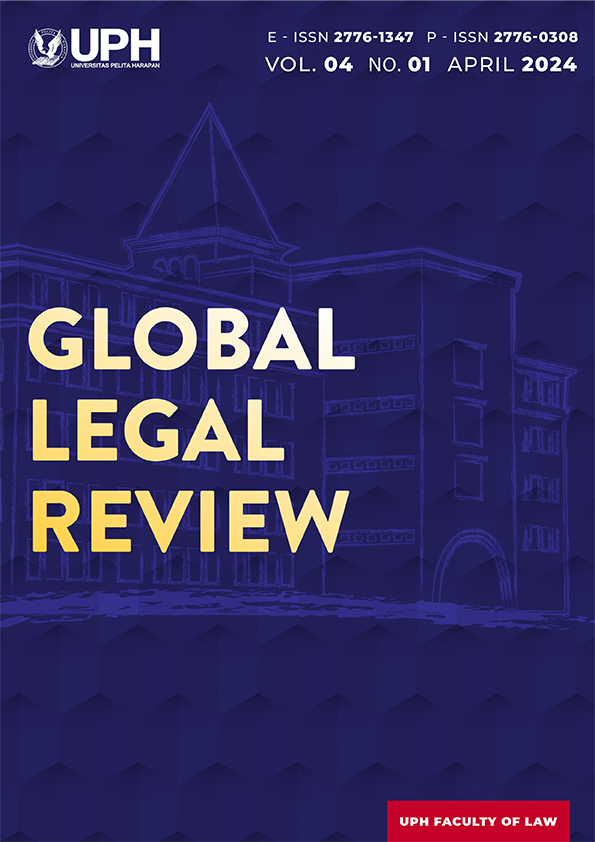Effectiveness of Law Enforcement on Corporate Bankruptcy Status
DOI:
https://doi.org/10.19166/glr.v4i1.6077Keywords:
Law Enforcement, Bankruptcy, Simple ProofAbstract
This study aims to evaluate the effectiveness of law enforcement on the status of bankruptcy in Indonesia. Lawrence M. Friedman's legal system theory is used because it has a comprehensive scope to evaluate the effectiveness of enforcing legislation. This study uses juridical-normative research with statutory and case approach. The laws and regulations studied are Law no. 37 of 2004 concerning Bankruptcy and Postponement of Debt Payment Obligations (KPKPU), while the case study takes the case of the bankruptcy of Telkomsel in 2012. This study finds that bankruptcy law enforcement in Indonesia has not been effective. This is because Indonesian bankruptcy law still has weaknesses in terms of substance, structure, and legal culture. In addition, this study finds that the fundamental weakness of Law no. 37 of 2004 is the application of simple proof as a mechanism for imposing bankruptcy statements to debtors. The application of this simple evidence makes law enforcers (judges) tend to ignore facts other than the two conditions stipulated in Law no. 37 of 2004 to impose bankruptcy status, namely the existence of two or more creditors and the existence of one debt that is due and collectible. In the end, the simple evidence mechanism does not open up opportunities for law enforcement officials to assess the debtor's ability to pay off their debts.
References
Campbell, Enid, E. J. Glasson, Lee Poh York, and Jennifer M. Sharpe. Legal Research: Materials and Methods. 4th ed. Sydney: The Law Book Company Ltd., 1996.
Cohen, Morris L., and Kent C. Olson. Legal Research in A Nutshell. St. Paul, Minnesota: West Publishing Company, 1992.
Friedman, Lawrence M. American Law. New York: W.W. Norton & Company, 1984.
Friedman, Lawrence M. Sistem Hukum Perspektif Ilmu Sosial. Bandung, Indonesia: Nusa Media, 2017.
Hamdani, Deni. “Analisis Likuiditas, Solvabilitas, dan Profitabilitas untuk Memprediksi Tingkat Kepailitan Media di Indonesia (Studi Pada Emiten Subsektor Advertising, Printing dan Media di Bursa Efek Indonesia Periode 2006-2009).” Jurnal Indonesia Membangun 14, no. 3 (September-December 2015): 123-147. https://jurnal.inaba.ac.id/index.php/JIM/article/view/50.
Heriani, Fitri N. "Enam Kesalahan UU Kepailitan." Hukum Online, October 9, 2015. https://www.hukumonline.com/berita/a/enam-kesalahan-uu-kepailitan-lt561737ed1a1cb/.
Marzuki, Peter Mahmud. Penelitian Hukum. Jakarta: Prenada Media, 2005.
Muljadi, Kartini and Gunawan Widjaja. Pedoman Menangani Perkara Kepailitan. Jakarta: Raja Grafindo Persada, 2007.
Muljadi, Kartini and Gunawan Widjaja. Pedoman Menangani Perkara Kepailitan. Jakarta: Raja Grafindo Persada, 2004.
Prabaningsih, Luh ayu Maheswari and Made Nurmawati. “Pengaturan Insolvency Test Dalam Penjatuhan Putusan Pailit Terhadap Perusahaan.” Kertha Semaya: Journal Ilmu Hukum 7, no. 9 (July 2019): 1-15. https://doi.org/10.24843/KM.2019.v07.i08.p14.
Prihatmaka, Hervana Wahyu, Sunarmi, and Rahmad Hendra. “Insolvensi dalam Hukum Kepailitan di Indonesia (Studi Putusan No. 48/Pailit/2012/Pn.Niaga.Jkt.Pst Antara PT.Telekomunikasi Selular vs PT. Primajaya Informatika).” Fiat Justisia 8, no. 2 (2014): 326-341. https://doi.org/10.25041/fiatjustisia.v8no2.295.
Simanjuntak, Ricardo. “Esensi Pembuktian Sederhana Dalam Kepailitan.” In Undang-Undang Kepailitan dan Perkembangannya, edited by Emmy Yuhassarie. Jakarta: Pusat Pengkajian Hukum, 2005.
Soekanto, Soerjono and Sri Mamudji. Penelitian Hukum Normatif: Suatu Tinjauan Singkat. Jakarta: PT RajaGrafindo Persada, 2001.
Soekanto, Soerjono. Faktor-Faktor Yang Mempengaruhi Penegakan Hukum. Jakarta: PT. Raja Grafindo Persada, 2002.
Suyudi, Aria, Eryanto Nugroho, and Herni Sri Nurbayanti. Kepailitan di Negeri Pailit. Jakarta: Pusat Studi Hukum dan Kebijakan Indonesia, 2004.
Watuseke, Sandy Marsel. “Peranan Lembaga Peradilan Niaga dalam Menyelesaikan Sengketa Pailit Menurut Undang-Undang No. 37 Tahun 2004.” Lex et Societatis 3, no. 4 (May 2015): 25-32. https://ejournal.unsrat.ac.id/index.php/lexetsocietatis/article/view/8050.
Wijayanta, Tata. “Penyelesaian Kes Kebankrutan di Pengadilan Niaga Indonesia dan Mahkamah Tinggi Malaysia: Suatu Kajian Perbandingan.” Thesis Doktor Falsafah, Universiti Kebangsaan Malaysia, 2008. Perpustakaan Tun Seri Lanang. http://ptsldigitalv2.ukm.my:8080/jspui/handle/123456789/389119.
Wijayanta, Tata. “Urgensi Pembentukan Pengadilan Niaga Baru.” Mimbar Hukum 22, no. 2 (2010): 330-346. http://dx.doi.org/10.22146/jmh.16230.
Downloads
Published
How to Cite
Issue
Section
License
Copyright (c) 2024 Benito Siregar

This work is licensed under a Creative Commons Attribution-ShareAlike 4.0 International License.
Authors who publish with this journal agree to the following terms:
1) Authors retain copyright and grant the journal right of first publication with the work simultaneously licensed under a Creative Commons Attribution License (CC-BY-SA 4.0) that allows others to share the work with an acknowledgement of the work's authorship and initial publication in this journal.
2) Authors are able to enter into separate, additional contractual arrangements for the non-exclusive distribution of the journal's published version of the work (e.g., post it to an institutional repository or publish it in a book), with an acknowledgement of its initial publication in this journal.
3) Authors are permitted and encouraged to post their work online (e.g., in institutional repositories or on their website). The final published PDF should be used and bibliographic details that credit the publication in this journal should be included.

